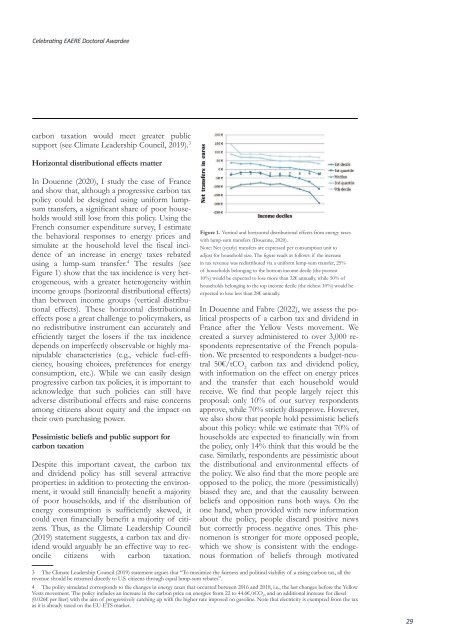EAERE Magazine - N.16 Spring 2022__
Create successful ePaper yourself
Turn your PDF publications into a flip-book with our unique Google optimized e-Paper software.
The Celebrating EU Module <strong>EAERE</strong> Doctoral Awardee<br />
carbon taxation would meet greater public<br />
support (see Climate Leadership Council, 2019). 3<br />
Horizontal distributional effects matter<br />
In Douenne (2020), I study the case of France<br />
and show that, although a progressive carbon tax<br />
policy could be designed using uniform lumpsum<br />
transfers, a significant share of poor households<br />
would still lose from this policy. Using the<br />
French consumer expenditure survey, I estimate<br />
the behavioral responses to energy prices and<br />
simulate at the household level the fiscal incidence<br />
of an increase in energy taxes rebated<br />
using a lump-sum transfer. 4 The results (see<br />
Figure 1) show that the tax incidence is very heterogeneous,<br />
with a greater heterogeneity within<br />
income groups (horizontal distributional effects)<br />
than between income groups (vertical distributional<br />
effects). These horizontal distributional<br />
effects pose a great challenge to policymakers, as<br />
no redistributive instrument can accurately and<br />
efficiently target the losers if the tax incidence<br />
depends on imperfectly observable or highly manipulable<br />
characteristics (e.g., vehicle fuel-efficiency,<br />
housing choices, preferences for energy<br />
consumption, etc.). While we can easily design<br />
progressive carbon tax policies, it is important to<br />
acknowledge that such policies can still have<br />
adverse distributional effects and raise concerns<br />
among citizens about equity and the impact on<br />
their own purchasing power.<br />
Pessimistic beliefs and public support for<br />
carbon taxation<br />
Despite this important caveat, the carbon tax<br />
and dividend policy has still several attractive<br />
properties: in addition to protecting the environment,<br />
it would still financially benefit a majority<br />
of poor households, and if the distribution of<br />
energy consumption is sufficiently skewed, it<br />
could even financially benefit a majority of citizens.<br />
Thus, as the Climate Leadership Council<br />
(2019) statement suggests, a carbon tax and dividend<br />
would arguably be an effective way to reconcile<br />
citizens with carbon taxation.<br />
Figure 1. Vertical and horizontal distributional effects from energy taxes<br />
with lump-sum transfers (Douenne, 2020).<br />
Note: Net (yearly) transfers are expressed per consumption unit to<br />
adjust for household size. The figure reads as follows: if the increase<br />
in tax revenue was redistributed via a uniform lump-sum transfer, 25%<br />
of households belonging to the bottom income decile (the poorest<br />
10%) would be expected to lose more than 32€ annually, while 50% of<br />
households belonging to the top income decile (the richest 10%) would be<br />
expected to lose less than 28€ annually.<br />
In Douenne and Fabre (<strong>2022</strong>), we assess the political<br />
prospects of a carbon tax and dividend in<br />
France after the Yellow Vests movement. We<br />
created a survey administered to over 3,000 respondents<br />
representative of the French population.<br />
We presented to respondents a budget-neutral<br />
50€/tCO 2<br />
carbon tax and dividend policy,<br />
with information on the effect on energy prices<br />
and the transfer that each household would<br />
receive. We find that people largely reject this<br />
proposal: only 10% of our survey respondents<br />
approve, while 70% strictly disapprove. However,<br />
we also show that people hold pessimistic beliefs<br />
about this policy: while we estimate that 70% of<br />
households are expected to financially win from<br />
the policy, only 14% think that this would be the<br />
case. Similarly, respondents are pessimistic about<br />
the distributional and environmental effects of<br />
the policy. We also find that the more people are<br />
opposed to the policy, the more (pessimistically)<br />
biased they are, and that the causality between<br />
beliefs and opposition runs both ways. On the<br />
one hand, when provided with new information<br />
about the policy, people discard positive news<br />
but correctly process negative ones. This phenomenon<br />
is stronger for more opposed people,<br />
which we show is consistent with the endogenous<br />
formation of beliefs through motivated<br />
3 The Climate Leadership Council (2019) statement argues that “To maximize the fairness and political viability of a rising carbon tax, all the<br />
revenue should be returned directly to U.S. citizens through equal lump-sum rebates”.<br />
4 The policy simulated corresponds to the changes in energy taxes that occurred between 2016 and 2018, i.e., the last changes before the Yellow<br />
Vests movement. The policy includes an increase in the carbon price on energies from 22 to 44.6€/tCO 2<br />
, and an additional increase for diesel<br />
(0.026€ per liter) with the aim of progressively catching up with the higher rate imposed on gasoline. Note that electricity is exempted from the tax<br />
as it is already taxed on the EU-ETS market.<br />
29













